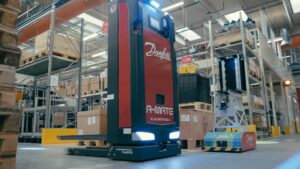USD 5.8 billion! That’s the amount of money that was invested in dark stores globally in the first 9 months of last year. And that number is only set to grow.
Primarily operating in urbanised areas, these dark stores act as fulfilment centres allowing e-commerce players to rapidly fill and deliver online orders to customers.
“Urban logistics or warehouse space close to city centres across Europe and a number of Asian cities is super expensive,” says Marie Hickey, Director Retail Research, Savills. “Historically, the model has largely focused on deliveries being fulfilled from large warehouses. But what retailers have realised is that this approach can mean the last mile piece is costly but also takes longer, counter to customer expectations for speedier deliveries,” she explains.
“In a dark store, you have pickers using different types of carts, containers or dollies. They are guided by e.g. hand-held devices or voice-picking technologies and pick products individually for multiple orders in batches,”, explains Stefan Lindh, Head of Business Unit Retail at K.Hartwall. “This allows a level of flexibility and speed that is unmatched by big warehouses operating in the outskirts, and even regular commercial storefronts since these are not open to the public.
Their presence has enabled the rise of rapid delivery and on-demand services in everything ranging from food to groceries to other consumer goods. Technology research firm Interact Analysis estimates that the number of dark stores globally will increase more than 7 fold from the current 6,000 to 45,000 by 2030.
That said, the rapid rise of dark stores is not without its share of problems.
The need for automation
Across Europe, complaints are being raised about the presence of dark stores in urban areas with critics claiming they are disruptive, a hazard to the public, or that they make too much noise. Recently, France came out with a law demanding dark stores be classified as warehouses, which could lead to large-scale closures as there are strict rules about warehouses operating in city limits. On top of this, dark stores are also grappling with rising delivery and customer acquisition costs.
Even so, dark stores are here to stay. According to a McKinsey report, Europe alone saw the top 15 grocery market players investing in more than 800 dark stores last year. So how can dark stores be made more profitable? Experts say automation is the answer.
“Multiple and varied logistics equipment across stores and geographies can be costly and inefficient in the long term,” explains Lindh. “Automation can help bring down costs. While the degree of automation a retailer wants depends on format and availability of finance; standardisation of equipment is a good place to start.”
This equipment needed to increase automation and standardisation is already in place. For example, K.Hartwall has released Automated Guided Vehicles (AGVs) that help decrease dependence on labour, improve the efficiency of your operations and increase safety, while roll containers such as Foldia® with special symmetrical folding designs make maximum use of the relatively limited space found in dark stores.
Gearing up for the future
As e-tailers ramp up efficiencies, they need to be aware that the regulatory environment is changing. Dark stores in many parts of the world including France, Amsterdam and New York will continue to face regulatory hurdles. Experts predict that consolidation may also be around the corner.
According to Interact Analysis, the race to drive down delivery costs will see a consolidation and lead to an acquisition spree amongst both brick & mortar retailers and rapid delivery companies with dark stores.
McKinsey’s report on the next horizon for grocery e-commerce says that
grocers will have to revisit how and where they fulfil orders. It predicts that the network of the grocer of the future will encompass a mix of automated micro-fulfilment centres, manual dark stores, and store fulfilment.
The time to act is now.



